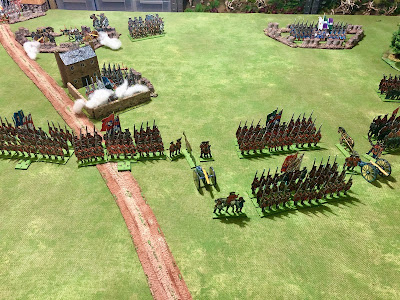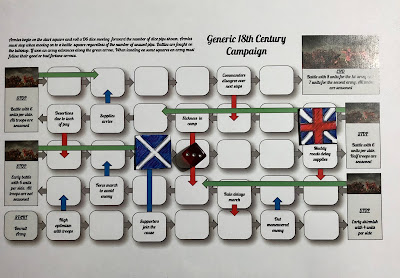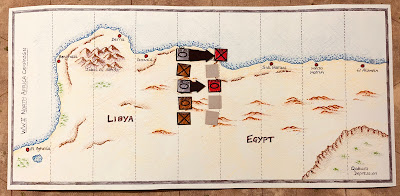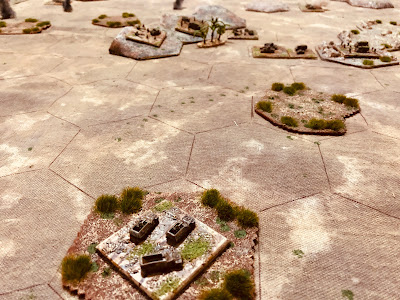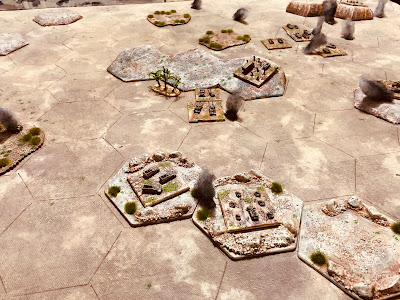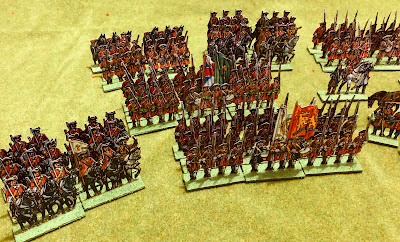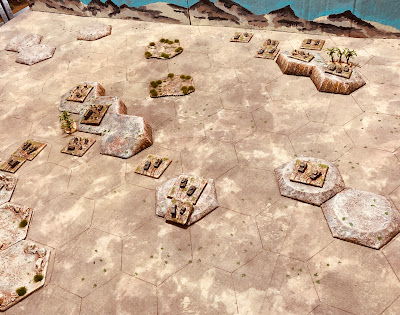Having successfully made advances in their last game with the 21st Panzer division. The Axis forces make their second attack with the 15th Panzer division against the Allied 1st Armoured division, a collection of armoured units.Campaign Map
Closer view of the second attack by 15th Panzer Division
As usual the terrain was decided by the cards and the forces diced to see the impact of wear and tear, previous losses, and supply situation. For this battle only wear and tear was diced for by both sides, a score of 1 removes the unit from being involved in the action.
Terrain cards determine the initial layout. Both the defending Allies and attacking Axis sides were allowed to swap to adjacent cards to adjust the terrain to their advantage.
The tabletop is laid out and objectives decided. The Axis forces will advance from the top.
Axis forces lose both armoured car units to wear and tear dice rolls.
Allied forces fare slightly worse with wear and tear losing three units: a Stuart tank, a Crusader tank and one 25 pounder artillery unit.
The type of game was next diced for:
- Both Allied and Axis forces would have a third of their units in reserve which can start arriving from turn 2 onwards on their base edge.
- Axis forces have a flanking force of one-third of their total, which can arrive on turn 2 onwards on either flank, but all forces must arrive from one flank side.
- Allied forces are taking an aggressive defence and can advance half their available tabletop forces anywhere providing it is not in range of Axis units.
Opening positions
Openning positions
A small combined force of the 15th Panzer division occupies a small escarpment. The advance positioning of Allied forces has them able to launch an armoured attack on the escarpment. This looked promising and resulted in Axis tank losses. Panzer reserves arrived quickly to bolster the position and anti-tank fire proved effective, driving the Allies back to their original position. An RAF sortie proved very effective destroying a tank unit and most importantly an 88mm gun unit. This dented any thoughts of a quick counterattack.
The initial Allied armoured attack
AT shooting drives off the Allied tanks and reserves begin to arrive.
Allied air sortie proves very destructive.
Facing strong opposition panzer flanking units begin to arrive, while Allied reserve units start to arrive to bolster their line. The flanking force was cautious while Allied units were repositioned to counter them.
The arrival of flanking armoured infantry
View of the tabletop
More flanking forces arrive
The mid-point of the game saw Allied tanks, now bolstered with reserve units, make another attack on the escarpment. Only to be driven off again be accurate AT shooting. This seemed to be a turning point in the game as the final panzer reserves arrived and a sortie by Stukas eliminated the sole Allied artillery unit.
Allied armour mount a second attack on the escarpment.
On the back of good AT shooting, Axis forces make a successful counterattack.
Axis forces quickly move forward.
Flanking forces push round the rear of the central escarpment and seal a victory.
While the flanking panzer force had not made any real inroads to the Allied central position, they had drawn away a few Allied units. On the back of driving off the second Allied tank attack with effective AT shooting, Axis forces were able to mount a successful counter attack which was able to sweep forward. Facing threats from both flanks now Allied forces concentrated around the centre escarpment position.
This allowed Axis forces to push forward to hold two of the three objectives giving them victory. This being their second victory of campaign turn 5, Axis forces will be able to advance their army one zone.










